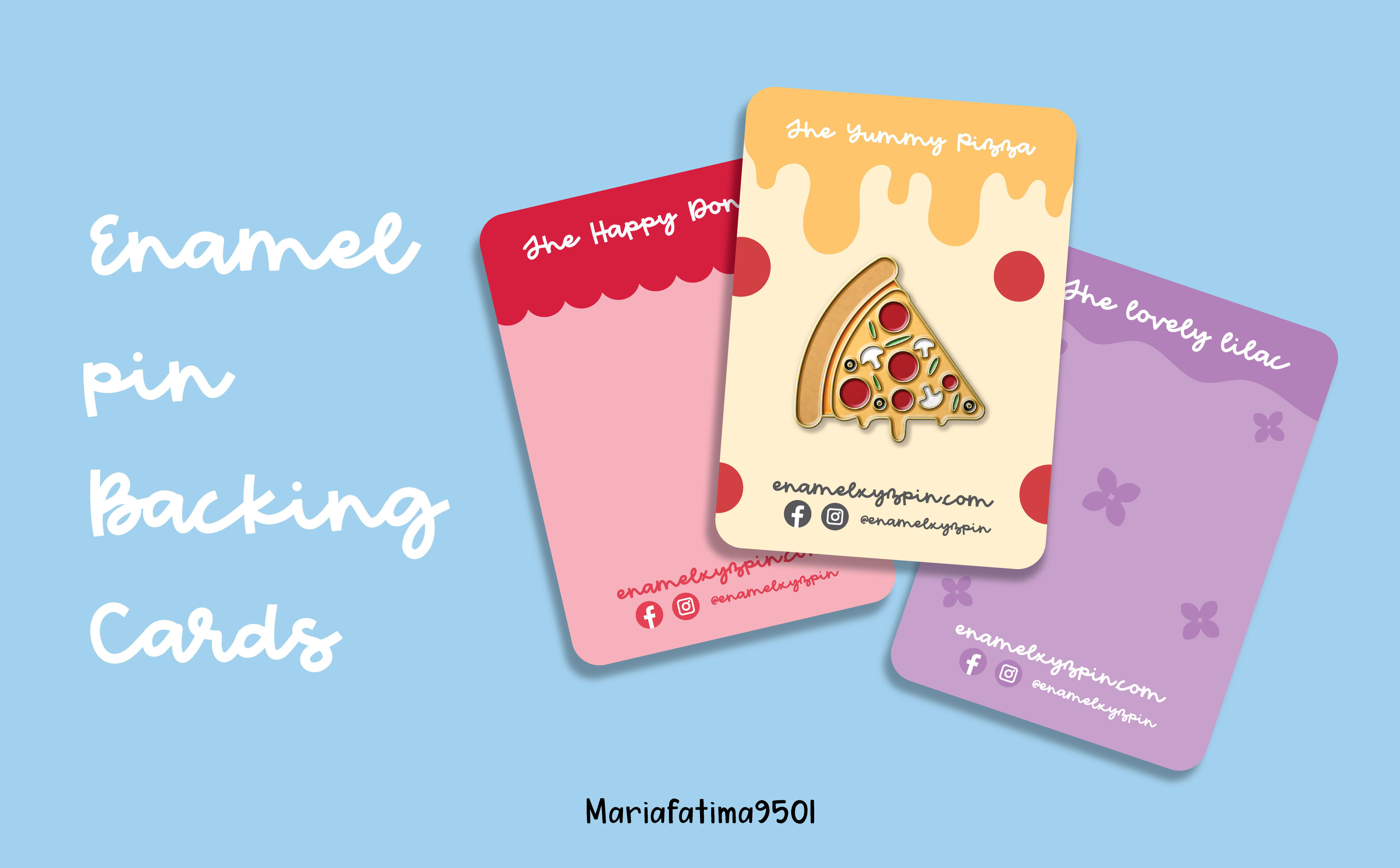Imagine your custom enamel pins as shining stars—beautiful and unique, but needing the perfect backdrop to truly shine. Enter the backer card: the stage that not only presents your pins but also tells the story of your brand. A well-designed backer card can transform your pin into an unforgettable keepsake, one that captures attention both in person and online. In this blog, we’ll guide you through every step of creating the perfect backer card—from choosing the right size, including the right details, to eye-catching designs, and tips for flawless integration. Ready to make your pins irresistible? Let’s dive in!

1. Choosing the Right Size for Your Backer Card
A great backer card starts with the right dimensions. When designing backer cards, it’s essential to match the size of your card with the size of your enamel pin. Here are some considerations:
- General Sizing Guide: Typically, backer cards range from 2×2 inches to 4×6 inches. For smaller pins (less than 1.5 inches), a 2×2 inch card works well. Larger or more elaborate pins look better on larger cards—something around 3×4 or 4×6 inches.
- Pin-to-Card Ratio: Ideally, the card should be about 1.5 to 2 times the size of the pin. This provides enough space for the pin to stand out without overwhelming the card or vice versa.
- Examples from the Industry: Many sellers use a 3×3 inch card for standard pins, which offers enough space for branding while keeping the pin as the central focus. Remember, sizing isn’t just about aesthetics—cards that are too large may increase shipping costs.
2. What Information Should Be Included on Backer Cards?
Your backer card is not only a holder but also a communication tool that conveys your brand’s identity and provides essential information to the buyer. Here are the elements to include:
- Brand Name and Logo: Make sure your logo is prominently displayed. This makes the product instantly recognizable and helps build brand loyalty.
- Social Media Handles: Adding social media handles encourages customers to tag you, providing free publicity. For example, placing a simple “@blythepin” can motivate buyers to share on Instagram or TikTok.
- Product Details or Catchphrases: You can add a catchy slogan or tagline to reflect your brand’s personality. For example, “Enamel Pins to Pin Your Story” can add a touch of uniqueness.
- Website or QR Code: To connect with your buyers even after purchase, include your website or add a QR code that directs them to your website or product catalog.
- Care Instructions or Warnings: If your pin is particularly fragile or if there are sharp points, a brief note on care instructions will help keep customers informed.

3. Graphic Design Considerations: Patterns, Colors, and Imagery
The design of your backer card should complement your pin, not overshadow it. Here are some graphic design tips:
- Color Coordination: Use colors that either contrast or complement the colors of the enamel pin. For example, if you have a bright pin, consider a neutral backer card to make it pop. Conversely, a pastel-colored pin may look fantastic against a dark, bold card background.
- Patterns and Backgrounds: Adding subtle patterns can give the card depth without being too busy. Simple textures like polka dots, stripes, or subtle gradients work well.
- Consider White Space: Leave ample blank space around the pin to ensure it’s the focal point. Cluttered backer cards can take the attention away from the pin itself.
- Examples of Successful Designs: Take inspiration from popular themes—minimalist designs for sleek, modern pins or illustrative backgrounds that enhance the storytelling aspect of themed pins. For instance, a sailor-themed pin on a backer card that mimics ocean waves adds narrative context.
4. Tips for Making Backer Cards and Pins Harmonize Perfectly
The harmony between the pin and the backer card can make or break your product’s appeal. Here are a few tips to make sure they work well together:
- Pin Positioning: Always consider the positioning of the pin on the card. The placement should be central or slightly above center, creating a balanced visual that draws the eye naturally.
- Attachment Methods: Pins can be affixed using butterfly clutches or rubber backings. Whichever you choose, make sure they don’t pierce through key parts of the backer card design like the logo or text.
- Branding Consistency: Ensure your brand colors and fonts are consistent across both the card and pin. This not only looks professional but reinforces brand identity.
- Material Matters: The card stock quality also matters. Using high-quality matte or gloss cardstock adds to the premium feel. For those who want a more environmentally friendly approach, recycled paper options are available and becoming increasingly popular.
Conclusion: Let Blythepin Help You Create Perfect Backer Cards
Creating backer cards that perfectly complement your pins requires a good understanding of both design and functionality. At Blythepin, we take pride in offering custom pin solutions that include the right backer cards tailored to your pins. Our expert design team can help guide you from concept to creation, ensuring that your final product stands out in both online and offline marketplaces.
Our custom backer cards can be crafted with special printing effects such as metallic foil or UV spots, enhancing your pin’s presentation while maintaining cost-effectiveness. We believe in providing a product that’s both visually appealing and functionally strong.
Ready to elevate your pin game? Visit our website Blythepin today to get started!



